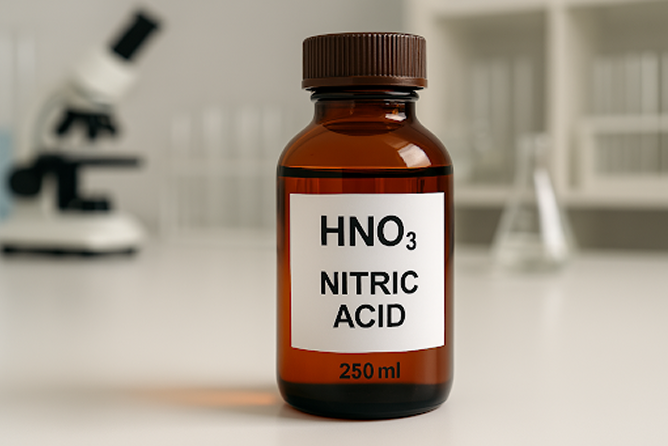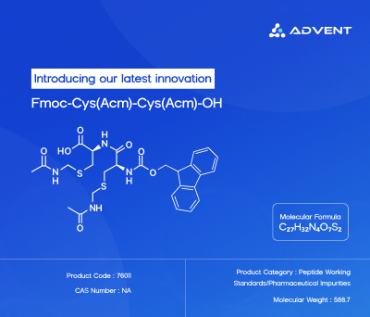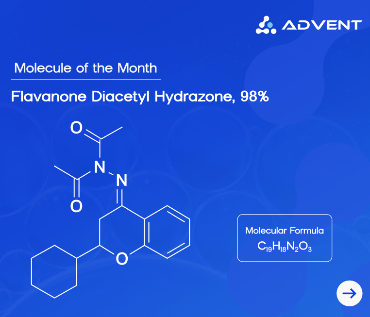Nitric acid, called aqua fortis or spirit of nitre, is a highly versatile and reactive chemical. Because of its three oxygen bonds, the other IUPAC name of nitric acid also consists of hydroxidotrioxidonitrogen and hydrogen(trioxidonitrate). Produced from ammonia, the production industry requires nitric acid, which has versatile uses across various sectors, ranging from its use in the production of plastics, polymers, medicines, and many other products. However, this is not all; nitric acid is also helpful in different aspects besides chemical synthesis.
In this article, we will try to figure out some engaging facts about nitric acid, an overview of its properties, a range of applications and the best place to purchase nitric acid.
Overview and Properties of Nitric Acid
Nitric acid (HNO₃) is a strong, corrosive mineral acid and powerful oxidising agent widely used in the chemical industry for multiple reactions such as redox, oxidation and synthesis of explosives. It appears as a colourless liquid at room temperature that can turn yellow with duration due to decomposition, resulting in nitrogen oxides over time. Nitric acid, also called aqua fortis, is key in producing fertilisers, explosives, and various chemicals. The acid has a density of 1.51 g/cm³ and a freezing point of -42 °C with a boiling point of 83 °C; nitric acid readily donates protons in solution.
Chemical Composition:
Molecular Formula: HNO₃
Molecular Weight: 63.01 g/mol
Constituents:
Hydrogen (H) – 1 atom
Nitrogen (N) – 1 atom
Oxygen (O) – 3 atomsFunctional Group: Nitrate group (-ONO₂) One nitrogen atom bonded to three oxygen atoms. One oxygen atom is bonded via a double bond, one via a single bond with a negative charge, and another via an –OH group.
Reactivity: Reacts with non-metals and organic compounds and decomposes into nitrogen oxides (NO₂) and water, especially when exposed to light or heat; nitric acid is inflammable but also supports combustion by supplying oxygen.
Preparation Of Nitric Acid
Nitric acid production through ammonia catalytic oxidation operates primarily on industrial and commercial levels. The Ostwald process represents the entire procedure used to manufacture nitric acid, in which ammonia is converted into nitric acid, a three-step process.
Industrial Applications of Nitric Acids
Due to its highly reactive and oxidising nature, nitric acid is vital in numerous industrial processes. Its most recognised use is in producing nitrate-based fertilisers like ammonium nitrate and calcium nitrate. Beyond agriculture, it also serves a wide range of industries, like manufacturing explosives such as TNT (trinitrotoluene), ammonal, and nitroglycerin and the synthetic chemical synthesis of polymers like nylon.
The reactive acid is also used as a solubiliser of noble elements and in synthesising dyes and pharmaceutical products. Nitric acid is used in refining precious metals like gold, silver, and platinum, especially when combined with hydrochloric acid in aqua regia.
Laboratory Applications of Nitric Acid
Nitric acid is an essential chemical in laboratory environments due to its versatility and reactivity. Typical uses include nitric acid as a catalyst in various chemical reactions, as it aids the decomposition without undergoing permanent or destructive chemical changes. Facilitates the precipitation of inorganic compounds like iron hydroxide from solutions. Nitric acid is also used as a spectroscopic reagent in spectroscopic analysis to detect and characterise organic and inorganic substances.
It is a preferred acid for Inductively Coupled Plasma Mass Spectrometry (ICP-MS). Its clean background contribution to the spectra of ICP-MS and availability at high purity levels from commercial sources make HNO3 the top choice of acid when preparing samples for metal analysis.
The other laboratory use of nitric acid is that it is used as a cleaning agent, as it aids in cleaning and preparing metal and glassware surfaces by removing organic and inorganic contaminants.
It also efficiently oxidises compounds such as alcohols, ketones, and aldehyde in oxidation reactions. Another significant application of nitric acid is its use in nitration reactions in which the acid introduces nitro groups (-NO₂) to organic molecules; this is a fundamental step in synthesising aromatic compounds.
Pharmaceutical Applications of Nitric Acid
Nitric acid is equally significant in the pharmaceutical sector, where its reactivity supports various drug development and testing stages used in forming building blocks for active drug ingredients and creating pharmaceutical intermediates through nitration. Nitric acid also plays a role in preparing solutions or reagents for redox titrations, pH tests, and compound analysis in quality control labs. Nitric acid assists in identifying degraded substances or impurities in drug products to improve safety and effectiveness.
The acid aids in preserving and stabilising compounds that may degrade over time. Besides the general application, it produces inactive ingredients (excipients) that improve shelf life and product uniformity.
Role in Protein Digestion and Peptide Mapping
The potent antioxidant function of nitric acid allows it to break down complex proteins by reducing them into simpler peptide fragments suitable for analysis.
Biological functions heavily depend on proteins because their structure directly relates to their activity within the human body. Scientists utilise nitric acid to break proteins into peptide segments, making identifying unique functional protein areas possible. Pharmacological research and system-based protein analysis succeed because scientists can identify crucial disease-related structures in proteins through this process.
Proper Safety Measures Needed When Handling Nitric Acid
Working professionals must observe detailed safety protocols because nitric acid is hazardous and corrosive. The following steps represent essential safety measures needed when working with nitric acid:
Prevent Skin Contact: Contacts with nitric acid directly to the skin will produce devastating chemical burns. Keep skin clean by rinsing with abundant water when nitric acid comes into contact with your skin.
Proper Storage: Nitric acid must be ideally stored in amber colour containers with an acid-resistant lining. Place the solution away from heat sources and direct sunlight; appropriate labels should be displayed while storing the solution. The strong acid should be accessible only to trained personnel who have received authorisation.
Avoid Inhalation: Nitric acid relieves strong vapours and a pungent smell that can damage the respiratory system and cause discomfort to respiratory tissues. Human exposure to nitric acid vapours through breathing leads to respiratory problems such as coughing, throat discomfort, and restricted breathing.
Eye Protection: When nitric acid is in contact with the eyes, it will damage permanent vision. In case of eye exposure to nitric acid, follow 15 minutes of water rinsing and get immediate medical care.
Use Personal Protective Equipment (PPE): Chemical-resistant gloves, safety goggles, face shields, and lab coats must be worn for protection. A safety mask is necessary for safeguarding against the inhalation of fumes produced by nitric acid.
Ensure Proper Ventilation: Laboratory ventilation equipment like a fume hood with sufficient airflow should redirect hazardous vapours from the personnel and working area.
Where to Buy Nitric Acid
Nitric acid (HNO₃) is a powerful oxidising agent that is a strong mineral acid across multiple industries, including pharmaceutical manufacturing, metallurgy, agriculture, and environmental testing. The acid possesses powerful oxidising characteristics and nitrating abilities, making it essential in chemical synthesis, fertiliser production, and laboratory analysis.
At Advent, we provide nitric acid solutions in various high-purity grades, such as AR, LR, and EL, along with particular pharmacopoeial grades, to meet industry requirements. To serve both small-scale laboratory use and large-scale industries, nitric acid at Advent is available in millilitre (mL) - litre (L) containers. Each batch includes complete testing information alongside official quality documentation to meet all prevailing regulatory and industry standards. The pricing of the product varies depending on the grade and quantity.
To explore our full range of fine chemicals, including nitric acid, visit our website.





